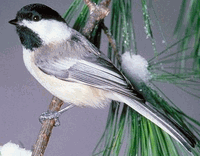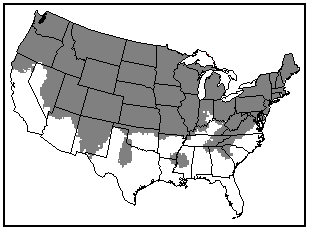Parus Atricapillus - Black-capped Chickadee
Description
Male, female and juvenile Black-capped Chickadees all have similar plumage. This species
has a black crown or "cap," a black chin and throat, and white cheek patches.
The back is greenish-gray, and the breast is white. The belly and flanks are buff-colored.
The tail is gray, and the wings are gray with white edges.
 Distribution
and Breeding Habitat
Distribution
and Breeding Habitat
Black-capped Chickadees inhabit the northern two-thirds of the United States and much of
Canada. They winter throughout their range and do not exhibit any formal, large-scale
migration patterns. Occasionally, there are sudden movements, or irruptions, of young
birds in the fall and early winter.
Black-capped Chickadees prefer mixed deciduous and coniferous forests. They are found both
at forest edges and deep within forests. They are also common in rural and suburban areas
containing scattered trees, such as old fields, thickets, and parks.
Diet
Black-capped Chickadees glean their prey from foliage and tree bark. Their diet consists
of insects, caterpillars, snails, and spiders. In the winter, they eat the berries and
seeds that they hid in the crevices of bark and under leaves. This behavior is called
caching, and Black-capped Chickadees can remember the location of the stored food for up
to a month after they hid it.
Pair Formation and Territoriality
Black-capped Chickadees are monogamous, and their pair bonds last for several years. Most
birds establish pair bonds in the late fall when winter flocks form. Nevertheless, some
birds die during the winter, and many birds must find new mates in the spring. Pairs
establish and defend a territory, remaining on or near their territory for the rest of
their lives.
Nesting Behavior
Nest Building: Generally, the breeding season begins in early April in
the southern portion of the range and in early May in the northern portion. The onset of
breeding, however, can be influenced by factors such as weather, food supply, and the
condition of the breeding female.
Black-capped Chickadees often nest in cavities they excavate themselves. They also nest in
natural cavities, abandoned woodpecker holes, and nest boxes. Excavation of the nest
cavity can take 7 to 10 days. Females usually build the nest in 3 to 5 days; however, this
may take as long as two weeks. The nest cup is made of moss and lined with rabbit fur,
plant down, hair, feathers, and spider webs. Nests are located at various heights but are
most commonly found one-and-a-half to seven meters off the ground.
Males feed their mates throughout the nest-building, egg-laying, and incubation periods.
Egg Laying: Black-capped Chickadees can lay their eggs anytime between
mid-April and early July. Laying begins one to two days after the nest is finished.
Females lay one egg per day, in the morning. They cover the eggs with nesting material
whenever they leave the nest. A complete clutch contains six to eight eggs. The eggs are
small, pinkish-white, and nonglossy, with red, brownish red, or purplish red specks evenly
distributed over the egg. Often, there are heavier spots at the larger end of the egg.
Incubation: Only the female incubates, and she begins on the day the next
to last, or penultimate, egg is laid. The incubation period lasts 12 to 13 days.
Nestling Care: The female broods the nestlings for a few days after
hatching. The amount of time she spends brooding the young gradually decreases but doesn't
stop completely until the nestlings are around 12 days old. The male does most of the
feeding of the young, but after the female ceases brooding, she and her mate feed equally.
At 16 days, the young fledge. They continue to be fed by the parents for two to four weeks
after they leave the nest, although they can feed themselves after 10 days.
Black-capped Chickadees have one brood per season. Double broods are rare. Females,
however, will attempt a replacement brood if the first nest attempt fails. They do not
reuse old nest sites.
Winter Movement and Dispersal
 Although the species does not
exhibit large-scale migration patterns, there are sudden large-scale movements, or
"irruptions." These spontaneous movements are apparently a juvenile dispersal
mechanism, because individuals moving in irruptions tend to be birds less than a year old.
But, much more needs to be learned about juvenile dispersal. What prompts irruptions, how
far the young disperse, and whether the sexes disperse differentially are all unknown.
Although the species does not
exhibit large-scale migration patterns, there are sudden large-scale movements, or
"irruptions." These spontaneous movements are apparently a juvenile dispersal
mechanism, because individuals moving in irruptions tend to be birds less than a year old.
But, much more needs to be learned about juvenile dispersal. What prompts irruptions, how
far the young disperse, and whether the sexes disperse differentially are all unknown.
In winter, Black-capped Chickadees form semi-stable flocks composed of breeding birds and
unrelated young. Some members stay in the same flock for the entire winter, but others
associate with more than one flock and will float among flocks all winter. Black-capped
Chickadees may also form mixed-species flocks with Tufted Titmice and White-breasted
Nuthatches.
source: http://www.shawcreekbirdsupply.com/blackcapped_chickadee_info.htm
[ Home ] [ Bird overview ]